Application Layer and Applications - The Interface Between the Networks
OSI and TCP/IP Model
The
Open Systems Interconnection reference model is a layered, abstract
representation created as a guideline for network protocol design. The
OSI model divides the networking process into seven logical layers, each
of which has unique functionality and to which are assigned specific
services and protocols. In this model, information is passed from one
layer to the next, starting at the Application layer ISO OSI on
the transmitting host, proceeding down the hierarchy to the Physical
layer, then passing over the communications channel to the destination
host, where the information proceeds back up the hierarchy, ending at
the Application layer. The figure depicts the steps in this process. The Application layer ISO OSI,
Layer seven, is the top layer of both the OSI and TCP/IP models. It is
the layer that provides the interface between the applications we use to
communicate and the underlying network over which our messages are
transmitted. Application layer protocols are used to exchange data between programs running on the source and destination hosts. There are many Application layer protocols and new protocols are always being developed.
Although
the TCP/IP protocol suite was developed prior to the definition of the
OSI model, the functionality of the TCP/IP application layer protocols
fit roughly into the framework of the top three layers of the OSI model:
Application, Presentation and Session layers. Most TCP/IP application
layer protocols were developed before the emergence of personal
computers, graphical user interfaces and multimedia objects. As a
result, these protocols implement very little of the functionality that
is specified in the OSI model Presentation and Session layers.
The Presentation Layer
The Presentation layer has three primary functions:
-
Coding and conversion of Application layer data to ensure that data from the source device can be interpreted by the appropriate application on the destination device.
- Compression of the data in a manner that can be decompressed by the destination device.
- Encryption of the data for transmission and the decryption of data upon receipt by the destination.
Presentation
layer implementations are not typically associated with a particular
protocol stack. The standards for video and graphics are examples. Some
well-known standards for video include QuickTime and Motion Picture
Experts Group (MPEG). QuickTime is an Apple Computer specification for
video and audio, and MPEG is a standard for video compression and
coding. Among the well-known graphic image formats are Graphics
Interchange Format (GIF), Joint Photographic Experts Group (JPEG), and
Tagged Image File Format (TIFF). GIF and JPEG are compression and coding
standards for graphic images, and TIFF is a standard coding format for
graphic images.
The Session Layer
As
the name of the Session layer implies, functions at this layer create
and maintain dialogs between source and destination applications. The
Session layer handles the exchange of information to initiate dialogs,
keep them active, and to restart sessions that are disrupted or idle for
a long period of time. Most applications, like web browsers or e-mail
clients, incorporate functionality of the OSI layers 5, 6 and 7.
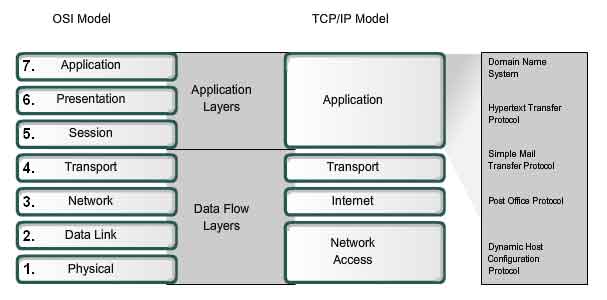
The most widely-known TCP/IP Application layer ISO OSI
protocols are those that provide for the exchange of user information.
These protocols specify the format and control information necessary for
many of the common Internet communication functions. Among these TCP/IP protocols are:
-
Domain Name Service Protocol (DNS) is used to resolve Internet names to IP addresses.
- Hypertext Transfer Protocol (HTTP) is used to transfer files that make up the Web pages of the World Wide Web.
- Simple Mail Transfer Protocol (SMTP) is used for the transfer of mail messages and attachments.
- Telnet, a terminal emulation protocol, is used to provide remote access to servers and networking devices.
- File Transfer Protocol (FTP) is used for interactive file transfer between systems.
The
protocols in the TCP/IP suite are generally defined by Requests for
Comments (RFCs). The Internet Engineering Task Force maintains the RFCs
as the standards for the TCP/IP suite.
Application Layer ISO OSI Software
The
functions associated with the Application layer protocols enable our
human network to interface with the underlying data network. When we
open a web browser or an instant message window, an application is
started, and the program is put into the device's memory where it is
executed. Each executing program loaded on a device is referred to as a
process. Within the Application layer, there are two forms of software
programs or processes that provide access to the network: applications
and services.
Network-Aware Applications
Applications
are the software programs used by people to communicate over the
network. Some end-user applications are network-aware, meaning that they
implement the application layer protocols and are able to communicate
directly with the lower layers of the protocol stack. E-mail clients and
web browsers are examples of these types of applications.
Application layer Services
Other programs may need the assistance of Application layer
services to use network resources, like file transfer or network print
spooling. Though transparent to the user, these services are the
programs that interface with the network and prepare the data for
transfer. Different types of data - whether it is text, graphics, or
video - require different network services to ensure that it is properly
prepared for processing by the functions occurring at the lower layers
of OSI model. Each application or network service uses protocols which
define the standards and data formats to be used. Without protocols, the
data network would not have a common way to format and direct data. In
order to understand the function of various network services, it is
necessary to become familiar with the underlying protocols that govern
their operation.
User Applications, Services, and Application Layer Protocols
As mentioned previously, the Application layer
uses protocols that are implemented within applications and services.
While applications provide people with a way to create messages and
application layer services establish an interface to the network,
protocols provide the rules and formats that govern how data is treated.
All three components may be used by a single executable program and may
even use the same name. For example, when discussing "Telnet" we could
be referring to the application, the service, or the protocol. In the
OSI model, applications that interact directly with people are
considered to be at the top of the stack, as are the people themselves.
Like all layers within the OSI model, the Application layer relies on
the functions of the lower layers in order to complete the communication
process. Within the Application layer, protocols
specify what messages are exchanged between the source and destination
hosts, the syntax of the control commands, the type and format of the
data being transmitted, and the appropriate methods for error
notification and recovery.
Application Layer Protocol Functions
Application layer ISO OSI
protocols are used by both the source and destination devices during a
communication session. In order for the communications to be successful,
the application layer protocols implemented on the source and
destination host must match. Protocols establish consistent rules for
exchanging data between applications and services loaded on the
participating devices. Protocols specify how data inside the messages is
structured and the types of messages that are sent between source and
destination. These messages can be requests for services,
acknowledgments, data messages, status messages, or error messages.
Protocols also define message dialogues, ensuring that a message being
sent is met by the expected response and the correct services are
invoked when data transfer occurs. Many different types of applications
communicate across data networks. Therefore, Application layer services
must implement multiple protocols to provide the desired range of
communication experiences. Each protocol has a specific purpose and
contains the characteristics required to meet that purpose. The right
protocol details in each layer must be followed so that the functions at
one layer interface properly with the services in the lower layer.
Applications and services may also use multiple protocols in the course
of a single conversation. One protocol may specify how to establish the
network connection and another describe the process for the data
transfer when the message is passed to the next lower layer.
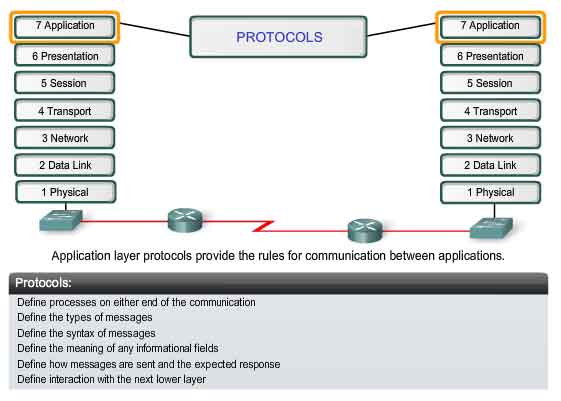
Application Layer - Making Provisions for Applications and Services
The Client-Server Model
When
people attempt to access information on their device, whether it is a
PC, laptop, PDA, cell phone, or some other device connected to a
network, the data may not be physically stored on their device. If that
is the case, a request to access that information must be made to the
device where the data resides.
The Client/Server model
In
the client/server model, the device requesting the information is
called a client and the device responding to the request is called a
server. Client and server processes are considered to be in the
Application layer. The client begins the exchange by requesting data
from the server, which responds by sending one or more streams of data
to the client. Application layer protocols describe the format of the
requests and responses between clients and servers. In addition to the
actual data transfer, this exchange may also require control
information, such as user authentication and the identification of a
data file to be transferred. One example of a client/server network is a
corporate environment where employees use a company e-mail server to
send, receive and store e-mail. The e-mail client on an employee
computer issues a request to the e-mail server for any unread mail. The
server responds by sending the requested e-mail to the client. Although
data is typically described as flowing from the server to the client,
some data always flows from the client to the server. Data flow may be
equal in both directions, or may even be greater in the direction going
from the client to the server. For example, a client may transfer a file
to the server for storage purposes. Data transfer from a client to a server is referred to as an upload and data from a server to a client as a download.
Servers
In a general networking context, any device that responds to requests from client applications is functioning as a server. A
server is usually a computer that contains information to be shared
with many client systems. For example, web pages, documents, databases,
pictures, video, and audio files can all be stored on a server and
delivered to requesting clients. In other cases, such as a network
printer, the print server delivers the client print requests to the
specified printer. Different types of server applications may have
different requirements for client access. Some servers may require
authentication of user account information to verify if the user has
permission to access the requested data or to use a particular
operation. Such servers rely on a central list of user accounts and the
authorizations, or permissions, (both for data access and operations)
granted to each user. When using an FTP client, for example, if you
request to upload data to the FTP server, you may have permission to
write to your individual folder but not to read other files on the site.
In a client/server network, the server runs a service, or process,
sometimes called a server daemon. Like most services, daemons typically
run in the background and are not under an end user's direct control.
Daemons are described as "listening" for a request from a client,
because they are programmed to respond whenever the server receives a
request for the service provided by the daemon. When a daemon "hears" a
request from a client, it exchanges appropriate messages with the
client, as required by its protocol, and proceeds to send the requested
data to the client in the proper format.
Application Layer Services and Protocols
A single application may employ many different supporting Application layer
services; thus what appears to the user as one request for a web page
may, in fact, amount to dozens of individual requests. And for each
request, multiple processes may be executed. For example, a client may
require several individual processes to formulate just one request to a
server. Additionally, servers typically have multiple clients requesting
information at the same time. For example, a Telnet server may
have many clients requesting connections to it. These individual client
requests must be handled simultaneously and separately for the network
to succeed. The Application layer processes and services rely on support
from lower layer functions to successfully manage the multiple
conversations.
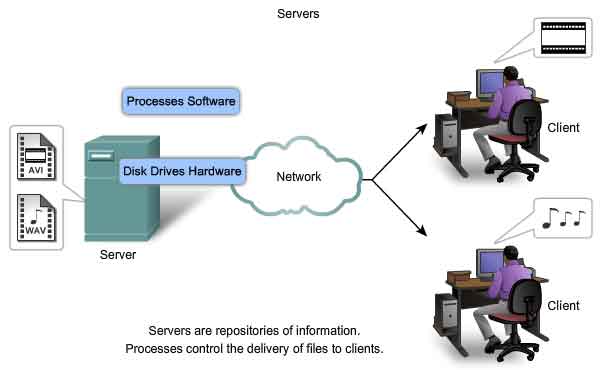
Peer-to-Peer Networking and Applications (P2P)
The Peer-to-Peer Model
The Peer-to-Peer Model
In
addition to the client/server model for networking, there is also a
peer-to-peer model. Peer-to-peer networking involves two distinct forms:
peer-to-peer network design and peer-to-peer applications (P2P). Both
forms have similar features but in practice work very differently.
Peer-to-Peer Networks
In
a peer-to-peer network, two or more computers are connected via a
network and can share resources (such as printers and files) without
having a dedicated server. Every connected end device (known as a peer)
can function as either a server or a client. One computer might assume
the role of server for one transaction while simultaneously serving as a
client for another. The roles of client and server are set on a per
request basis. A simple home network with two connected computers
sharing a printer is an example of a peer-to-peer network. Each person
can set his or her computer to share files, enable networked games, or
share an Internet connection. Another example of peer-to-peer network
functionality is two computers connected to a large network that use
software applications to share resources between one another through the
network. Unlike the client/server model, which uses dedicated servers,
peer-to-peer networks decentralize the resources on a network. Instead
of locating information to be shared on dedicated servers, information
can be located anywhere on any connected device. Most of the current
operating systems support file and print sharing without requiring
additional server software. Because peer-to-peer networks usually do not
use centralized user accounts, permissions, or monitors, it is
difficult to enforce security and access policies in networks containing
more than just a few computers. User accounts and access rights must be
set individually on each peer device.
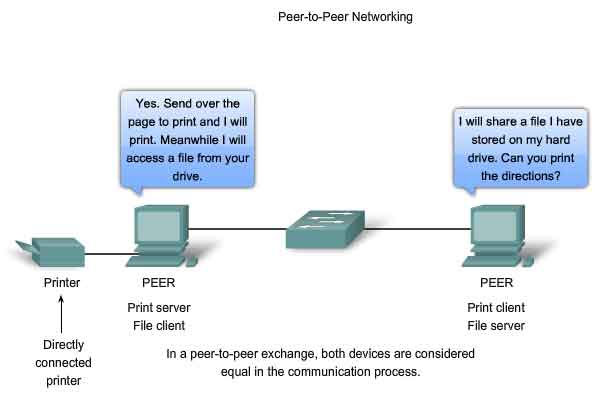
Peer-to-Peer Applications
A
peer-to-peer application (P2P), unlike a peer-to-peer network, allows a
device to act as both a client and a server within the same
communication. In this model, every client is a server and every server a
client. Both can initiate a communication and are considered equal in
the communication process. However, peer-to-peer applications require
that each end device provide a user interface and run a background
service. When you launch a specific peer-to-peer application it invokes
the required user interface and background services. After that the
devices can communicate directly. Some P2P applications use a hybrid
system where resource sharing is decentralized but the indexes that
point to resource locations are stored in a centralized directory. In a
hybrid system, each peer accesses an index server to get the location of
a resource stored on another peer. The index server can also help
connect two peers, but once connected, the communication takes place
between the two peers without additional communication to the index
server. Peer-to-peer applications can be used on peer-to-peer networks,
client/server networks, and across the Internet.
Application Layer ISO OSI Protocols and Services Examples
DNS Services and Protocol
Now that we have a better understanding of how applications provide an interface for the user and provide access to the network, we will take a look at some specific commonly used protocols. As we will see later in this course, the Transport layer uses an addressing scheme called a port number. Port numbers identify applications and Application layer services that are the source and destination of data. Server programs generally use predefined port numbers that are commonly known by clients. As we examine the different TCP/IP Application layer protocols and services, we will be referring to the TCP and UDP port numbers normally associated with these services. Some of these services are:
Now that we have a better understanding of how applications provide an interface for the user and provide access to the network, we will take a look at some specific commonly used protocols. As we will see later in this course, the Transport layer uses an addressing scheme called a port number. Port numbers identify applications and Application layer services that are the source and destination of data. Server programs generally use predefined port numbers that are commonly known by clients. As we examine the different TCP/IP Application layer protocols and services, we will be referring to the TCP and UDP port numbers normally associated with these services. Some of these services are:
-
Domain Name System (DNS) - TCP/UDP Port 53
- Hypertext Transfer Protocol (HTTP) - TCP Port 80
- Simple Mail Transfer Protocol (SMTP) - TCP Port 25
- Post Office Protocol (POP) - UDP Port 110
- Telnet - TCP Port 23
- Dynamic Host Configuration Protocol - UDP Port 67
- File Transfer Protocol (FTP) - TCP Ports 20 and 21
DNS
In
data networks, devices are labeled with numeric IP addresses, so that
they can participate in sending and receiving messages over the network.
However, most people have a hard time remembering this numeric address.
Hence, domain names were created to convert the numeric address into a
simple, recognizable name. On the Internet these domain names, such as
www.cisco.com, are much easier for people to remember than
198.133.219.25, which is the actual numeric address for this server.
Also, if Cisco decides to change the numeric address, it is transparent
to the user, since the domain name will remain www.cisco.com. The new
address will simply be linked to the existing domain name and
connectivity is maintained. When networks were small, it was a simple
task to maintain the mapping between domain names and the addresses they
represented. However, as networks began to grow and the number of
devices increased, this manual system became unworkable. The Domain Name
System (DNS) was created for domain name to address resolution for
these networks. DNS uses a distributed set of servers to resolve the
names associated with these numbered addresses. The DNS protocol
defines an automated service that matches resource names with the
required numeric network address. It includes the format for queries,
responses, and data formats. DNS protocol communications use a single
format called a message. This message format is used for all types of
client queries and server responses, error messages, and the transfer of
resource record information between servers.
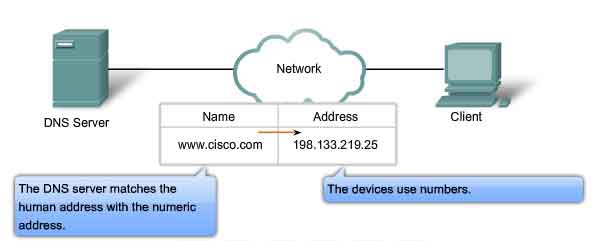
DNS
is a client/server service; however, it differs from the other
client/server services that we are examining. While other services use a
client that is an application (such as web browser, e-mail client), the
DNS client runs as a service itself. The DNS client, sometimes called
the DNS resolver, supports name resolution for our other network
applications and other services that need it. When configuring a network
device, we generally provide one or more DNS Server addresses
that the DNS client can use for name resolution. Usually the Internet
service provider provides the addresses to use for the DNS servers. When
a user's application requests to connect to a remote device by name,
the requesting DNS client queries one of these name servers to resolve
the name to a numeric address. Computer operating systems also have a
utility called nslookup that allows the user to
manually query the name servers to resolve a given host name. This
utility can also be used to troubleshoot name resolution issues and to
verify the current status of the name servers. In the figure, when the nslookup
is issued, the default DNS server configured for your host is
displayed. In this example, the DNS server is dns-sjk.cisco.com which
has an address of 171.68.226.120. We then can type the name of a host or
domain for which we wish to get the address. In the first query in the
figure, a query is made for www.cisco.com. The responding name server
provides the address of 198.133.219.25. The queries shown in the figure
are only simple tests. The nslookup has many options available for extensive testing and verification of the DNS process.
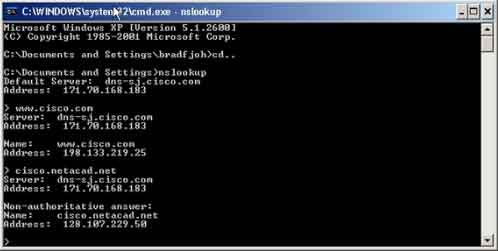
A
DNS server provides the name resolution using the name daemon, which is
often called named, (pronounced name-dee). The DNS server stores
different types of resource records used to resolve names. These records
contain the name, address, and type of record. Some of these record
types are:
-
A - an end device address
- NS - an authoritative name server
- CNAME - the canonical name (or Fully Qualified Domain Name) for an alias; used when multiple services have the single network address but each service has its own entry in DNS
- MX - mail exchange record; maps a domain name to a list of mail exchange servers for that domain
When
a client makes a query, the server's "named" process first looks at its
own records to see if it can resolve the name. If it is unable to
resolve the name using its stored records, it contacts other servers in
order to resolve the name. The request may be passed along to a number
of servers, which can take extra time and consume bandwidth. Once a
match is found and returned to the original requesting server, the
server temporarily stores the numbered address that matches the name in
cache. If that same name is requested again, the first server can return
the address by using the value stored in its name cache. Caching
reduces both the DNS query data network traffic and the workloads of
servers higher up the hierarchy. The DNS Client service on Windows PCs
optimizes the performance of DNS name resolution by storing previously
resolved names in memory, as well. The ipconfig /displaydns command displays all of the cached DNS entries on a Windows XP or 2000 computer system.
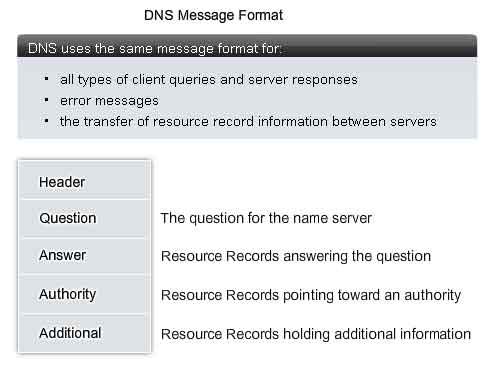
The
Domain Name System uses a hierarchical system to create a name database
to provide name resolution. The hierarchy looks like an inverted tree
with the root at the top and branches below. At the top of the
hierarchy, the root servers maintain records about how to reach the
top-level domain servers, which in turn have records that point to the
secondary level domain servers and so on. The different top-level
domains represent either the type of organization or the country of
origin. Examples of top-level domains are:
-
.au - Australia
- .co - Colombia
- .com - a business or industry
- .jp - Japan
- .org - a non-profit organization
After
top-level domains are second-level domain names, and below them are
other lower level domains. Each domain name is a path down this inverted
tree starting from the root. For example, as shown in the figure, the
root DNS server may not know exactly where the e-mail server
mail.cisco.com is located, but it maintains a record for the "com"
domain within the top-level domain. Likewise, the servers within the
"com" domain may not have a record for mail.cisco.com, but they do have a
record for the "cisco.com" domain. The servers within the cisco.com
domain have a record (a MX record to be precise) for mail.cisco.com. The
Domain Name System relies on this hierarchy of decentralized servers to
store and maintain these resource records. The resource records list
domain names that the server can resolve and alternative servers that
can also process requests. If a given server has resource records that
correspond to its level in the domain hierarchy, it is said to be authoritative
for those records. For example, a name server in the cisco.netacad.net
domain would not be authoritative for the mail.cisco.com record because
that record is held at a higher domain level server, specifically the
name server in the cisco.com domain.
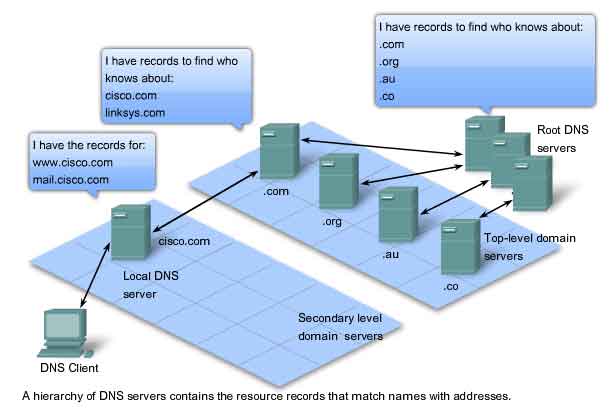
WWW Service and HTTP
When a web address (or URL) is typed into a web browser, the web browser establishes a connection to the web service running on the server using the HTTP protocol. URLs (or Uniform Resource Locator) and URIs (Uniform Resource Identifier) are the names most people associate with web addresses. The URL http://www.mysite.com/index.html is an example of a URL that refers to a specific resource - a web page named index.html on a server identified as mysite.com (click the tabs in the figure to see the steps used by HTTP). Web browsers are the client applications our computers use to connect to the World Wide Web and access resources stored on a web server. As with most server processes, the web server runs as a background service and makes different types of files available. In order to access the content, web clients make connections to the server and request the desired resources. The server replies with the resources and, upon receipt, the browser interprets the data and presents it to the user. Browsers can interpret and present many data types, such as plain text or Hypertext Markup Language (HTML, the language in which web pages are constructed). Other types of data, however, may require another service or program, typically referred to as plug-ins or add-ons. To help the browser determine what type of file it is receiving, the server specifies what kind of data the file contains. To better understand how the web browser and web client interact, we can examine how a web page is opened in a browser. For this example, we will use the URL: http://www.mysite.com/web-server.htm. First, the browser interprets the three parts of the URL:
When a web address (or URL) is typed into a web browser, the web browser establishes a connection to the web service running on the server using the HTTP protocol. URLs (or Uniform Resource Locator) and URIs (Uniform Resource Identifier) are the names most people associate with web addresses. The URL http://www.mysite.com/index.html is an example of a URL that refers to a specific resource - a web page named index.html on a server identified as mysite.com (click the tabs in the figure to see the steps used by HTTP). Web browsers are the client applications our computers use to connect to the World Wide Web and access resources stored on a web server. As with most server processes, the web server runs as a background service and makes different types of files available. In order to access the content, web clients make connections to the server and request the desired resources. The server replies with the resources and, upon receipt, the browser interprets the data and presents it to the user. Browsers can interpret and present many data types, such as plain text or Hypertext Markup Language (HTML, the language in which web pages are constructed). Other types of data, however, may require another service or program, typically referred to as plug-ins or add-ons. To help the browser determine what type of file it is receiving, the server specifies what kind of data the file contains. To better understand how the web browser and web client interact, we can examine how a web page is opened in a browser. For this example, we will use the URL: http://www.mysite.com/web-server.htm. First, the browser interprets the three parts of the URL:
1. http (the protocol or scheme)
2. www.mysite.com (the server name)
3. web-server.htm (the specific file name requested).
The
browser then checks with a name server to convert www.cisco.com into a
numeric address, which it uses to connect to the server. Using the HTTP
protocol requirements, the browser sends a GET request to the server and
asks for the file web-server.htm. The server in turn sends the
HTML code for this web page to the browser. Finally, the browser
deciphers the HTML code and formats the page for the browser window.
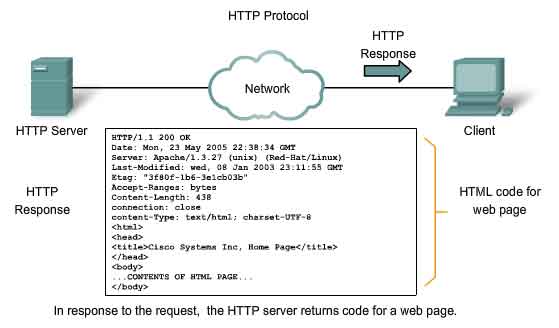
The
Hypertext Transfer Protocol (HTTP), one of the protocols in the TCP/IP
suite, was originally developed to publish and retrieve HTML pages and
is now used for distributed, collaborative information systems. HTTP is
used across the World Wide Web for data transfer and is one of the most
used application protocols.
HTTP
specifies a request/response protocol. When a client, typically a web
browser, sends a request message to a server, the HTTP protocol defines
the message types the client uses to request the web page and also the
message types the server uses to respond. The three common message types
are GET, POST, and PUT.
GET is a client request for data. A web browser sends the GET message to request pages from a web server. As shown in the figure, once the server receives the GET request,
it responds with a status line, such as HTTP/1.1 200 OK, and a message
of its own, the body of which may be the requested file, an error
message, or some other information.
POST and PUT are
used to send messages that upload data to the web server. For example,
when the user enters data into a form embedded in a web page, POST includes the data in the message sent to the server.
PUT uploads resources or content to the web server.
Although it is remarkably flexible, HTTP is not a secure protocol. The POST
messages upload information to the server in plain text that can be
intercepted and read. Similarly, the server responses, typically HTML
pages, are also unencrypted. For secure communication across the
Internet, the HTTP Secure (HTTPS) protocol is used for accessing or
posting web server information. HTTPS can use authentication and
encryption to secure data as it travels between the client and server.
HTTPS specifies additional rules for passing data between the
Application layer and the Transport Layer.
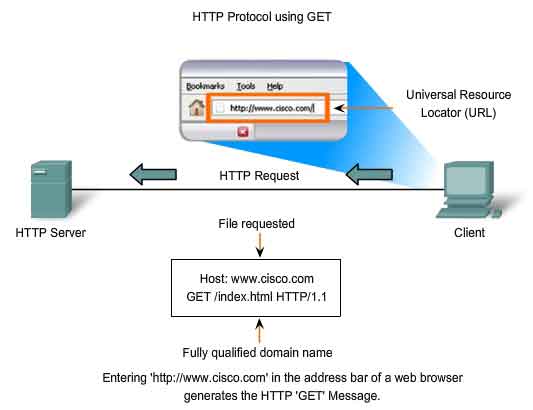
E-mail Services and SMTP/POP Protocols
E-mail,
the most popular network service, has revolutionized how people
communicate through its simplicity and speed. Yet to run on a computer
or other end device, e-mail requires several applications and services.
Two example Application layer protocols are Post Office Protocol (POP)
and Simple Mail Transfer Protocol (SMTP), shown in the figure. As
with HTTP, these protocols define client/server processes. When people
compose e-mail messages, they typically use an application called a Mail User Agent
(MUA), or e-mail client. The MUA allows messages to be sent and places
received messages into the client's mailbox, both of which are distinct
processes. In order to receive e-mail messages from an e-mail server,
the e-mail client can use POP. Sending e-mail from either a client or a
server uses message formats and command strings defined by the SMTP
protocol. Usually an e-mail client provides the functionality of both
protocols within one application.
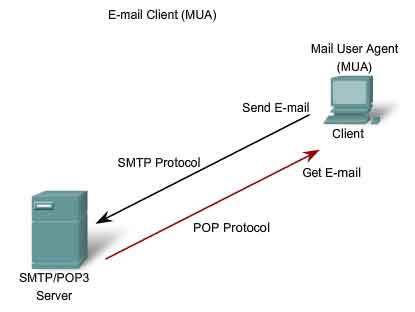
E-mail Server Processes - MTA and MDA
The e-mail server operates two separate processes:
-
Mail Transfer Agent (MTA)
- Mail Delivery Agent (MDA)
The
Mail Transfer Agent (MTA) process is used to forward e-mail. As shown
in the figure, the MTA receives messages from the MUA or from another
MTA on another e-mail server. Based on the message header, it determines
how a message has to be forwarded to reach its destination. If the mail
is addressed to a user whose mailbox is on the local server, the mail
is passed to the MDA. If the mail is for a user not on the local server,
the MTA routes the e-mail to the MTA on the appropriate server. In the
figure, we see that the Mail Delivery Agent (MDA) accepts a piece of
e-mail from a Mail Transfer Agent (MTA) and performs the actual
delivery. The MDA receives all the inbound mail from the MTA and places
it into the appropriate users' mailboxes. The MDA can also resolve final
delivery issues, such as virus scanning, spam filtering, and
return-receipt handling. Most e-mail communications use the MUA, MTA,
and MDA applications. However, there are other alternatives for e-mail
delivery. A client may be connected to a corporate e-mail system, such
as IBM's Lotus Notes, Novell's Groupwise, or Microsoft's Exchange. These
systems often have their own internal e-mail format, and their clients
typically communicate with the e-mail server using a proprietary
protocol. The server sends or receives e-mail via the Internet through
the product's Internet mail gateway, which performs any necessary
reformatting. If, for example, two people who work for the same company
exchange e-mail with each other using a proprietary protocol, their
messages may stay completely within the company's corporate e-mail
system. As another alternative, computers that do not have an MUA can
still connect to a mail service on a web browser in order to retrieve
and send messages in this manner. Some computers may run their own MTA
and manage inter-domain e-mail themselves.
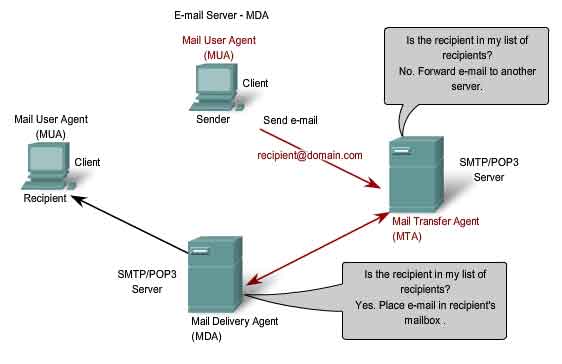
As
mentioned earlier, e-mail can use the protocols, POP and SMTP (see the
figure for an explanation of how they each work). POP and POP3 (Post
Office Protocol, version 3) are inbound mail delivery protocols
and are typical client/server protocols. They deliver e-mail from the
e-mail server to the client (MUA). The MDA listens for when a client
connects to a server. Once a connection is established, the server can
deliver the e-mail to the client. The Simple Mail Transfer Protocol
(SMTP), on the other hand, governs the transfer of outbound e-mail
from the sending client to the e-mail server (MDA), as well as the
transport of e-mail between e-mail servers (MTA). SMTP enables e-mail to
be transported across data networks between different types of server
and client software and makes e-mail exchange over the Internet
possible. The SMTP protocol message format uses a rigid set of commands
and replies. These commands support the procedures used in SMTP, such as
session initiation, mail transaction, forwarding mail, verifying
mailbox names, expanding mailing lists, and the opening and closing
exchanges.
Some of the commands specified in the SMTP protocol are:
-
HELO - identifies the SMTP client process to the SMTP server process
- EHLO - Is a newer version of HELO, which includes services extensions
- MAIL FROM - Identifies the sender
- RCPT TO - Identifies the recipient
- DATA - Identifies the body of the message
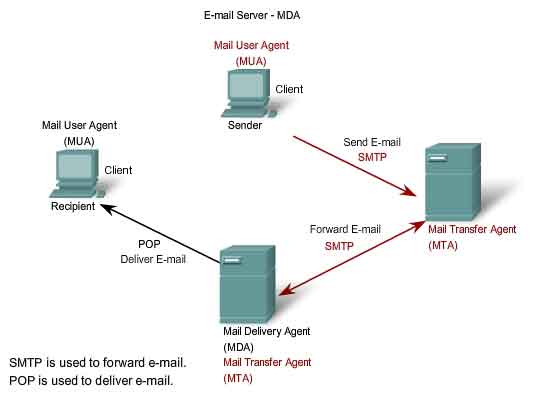
FTP
The File Transfer Protocol (FTP) is another commonly used Application layer protocol. FTP was developed to allow for file transfers between a client and a server. An FTP client is an application that runs on a computer that is used to push and pull files from a server running the FTP daemon (FTPd). To successfully transfer files, FTP requires two connections between the client and the server: one for commands and replies, the other for the actual file transfer. The client establishes the first connection to the server on TCP port 21. This connection is used for control traffic, consisting of client commands and server replies. The client establishes the second connection to the server over TCP port 20. This connection is for the actual file transfer and is created every time there is a file transferred. The file transfer can happen in either direction. The client can download (pull) a file from the server or, the client can upload (push) a file to the server.
The File Transfer Protocol (FTP) is another commonly used Application layer protocol. FTP was developed to allow for file transfers between a client and a server. An FTP client is an application that runs on a computer that is used to push and pull files from a server running the FTP daemon (FTPd). To successfully transfer files, FTP requires two connections between the client and the server: one for commands and replies, the other for the actual file transfer. The client establishes the first connection to the server on TCP port 21. This connection is used for control traffic, consisting of client commands and server replies. The client establishes the second connection to the server over TCP port 20. This connection is for the actual file transfer and is created every time there is a file transferred. The file transfer can happen in either direction. The client can download (pull) a file from the server or, the client can upload (push) a file to the server.
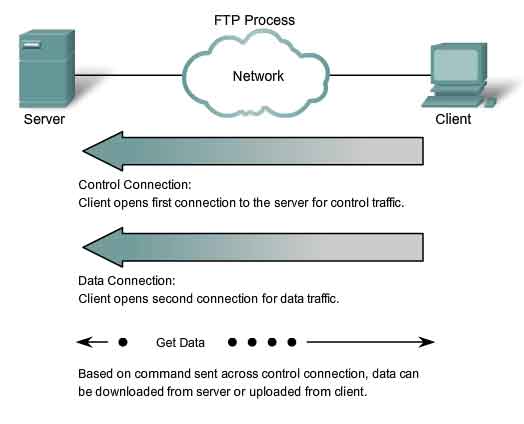
DHCP
The Dynamic Host Configuration Protocol (DHCP) service enables devices on a network to obtain IP addresses and other information from a DHCP server. This service automates the assignment of IP addresses, subnet masks, gateway and other IP networking parameters. DHCP allows a host to obtain an IP address dynamically when it connects to the network. The DHCP server is contacted and an address requested. The DHCP server chooses an address from a configured range of addresses called a pool and assigns ("leases") it to the host for a set period. On larger local networks, or where the user population changes frequently, DHCP is preferred. New users may arrive with laptops and need a connection. Others have new workstations that need to be connected. Rather than have the network administrator assign IP addresses for each workstation, it is more efficient to have IP addresses assigned automatically using DHCP. DHCP distributed addresses are not permanently assigned to hosts but are only leased for a period of time. If the host is powered down or taken off the network, the address is returned to the pool for reuse. This is especially helpful with mobile users that come and go on a network. Users can freely move from location to location and re-establish network connections. The host can obtain an IP address once the hardware connection is made, either via a wired or wireless LAN. DHCP makes it possible for you to access the Internet using wireless hotspots at airports or coffee shops. As you enter the area, your laptop DHCP client contacts the local DHCP server via a wireless connection. The DHCP server assigns an IP address to your laptop. As the figure shows, various types of devices can be DHCP servers when running DHCP service software. The DHCP server in most medium to large networks is usually a local dedicated PC-based server. With home networks the DHCP server is usually located at the ISP and a host on the home network receives its IP configuration directly from the ISP. DHCP can pose a security risk because any device connected to the network can receive an address. This risk makes physical security an important factor when determining whether to use dynamic or manual addressing. Dynamic and static addressing both have their places in network designs. Many networks use both DHCP and static addressing. DHCP is used for general purpose hosts such as end user devices, and fixed addresses are used for network devices such as gateways, switches, servers and printers.
The Dynamic Host Configuration Protocol (DHCP) service enables devices on a network to obtain IP addresses and other information from a DHCP server. This service automates the assignment of IP addresses, subnet masks, gateway and other IP networking parameters. DHCP allows a host to obtain an IP address dynamically when it connects to the network. The DHCP server is contacted and an address requested. The DHCP server chooses an address from a configured range of addresses called a pool and assigns ("leases") it to the host for a set period. On larger local networks, or where the user population changes frequently, DHCP is preferred. New users may arrive with laptops and need a connection. Others have new workstations that need to be connected. Rather than have the network administrator assign IP addresses for each workstation, it is more efficient to have IP addresses assigned automatically using DHCP. DHCP distributed addresses are not permanently assigned to hosts but are only leased for a period of time. If the host is powered down or taken off the network, the address is returned to the pool for reuse. This is especially helpful with mobile users that come and go on a network. Users can freely move from location to location and re-establish network connections. The host can obtain an IP address once the hardware connection is made, either via a wired or wireless LAN. DHCP makes it possible for you to access the Internet using wireless hotspots at airports or coffee shops. As you enter the area, your laptop DHCP client contacts the local DHCP server via a wireless connection. The DHCP server assigns an IP address to your laptop. As the figure shows, various types of devices can be DHCP servers when running DHCP service software. The DHCP server in most medium to large networks is usually a local dedicated PC-based server. With home networks the DHCP server is usually located at the ISP and a host on the home network receives its IP configuration directly from the ISP. DHCP can pose a security risk because any device connected to the network can receive an address. This risk makes physical security an important factor when determining whether to use dynamic or manual addressing. Dynamic and static addressing both have their places in network designs. Many networks use both DHCP and static addressing. DHCP is used for general purpose hosts such as end user devices, and fixed addresses are used for network devices such as gateways, switches, servers and printers.
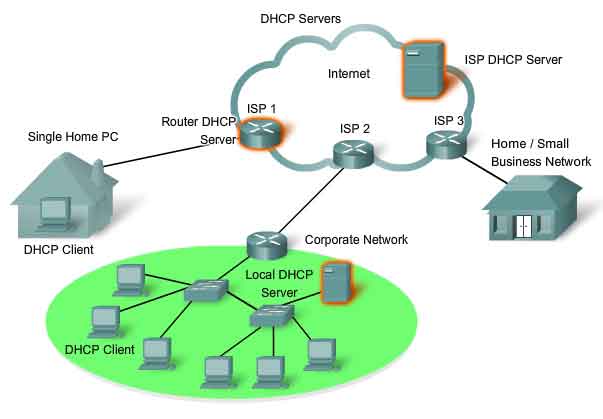
Without
DHCP, users have to manually input the IP address, subnet mask and
other network settings in order to join the network. The DHCP server
maintains a pool of IP addresses and leases an address to any
DHCP-enabled client when the client is powered on. Because the IP
addresses are dynamic (leased) rather than static (permanently
assigned), addresses no longer in use are automatically returned to the
pool for reallocation. When a DHCP-configured device boots up or
connects to the network, the client broadcasts a DHCP DISCOVER packet to
identify any available DHCP servers on the network. A DHCP server
replies with a DHCP OFFER, which is a lease offer message with an
assigned IP address, subnet mask, DNS server, and default gateway
information as well as the duration of the lease. The client may receive
multiple DHCP OFFER packets if there is more than one DHCP server on
the local network, so it must choose between them, and broadcast a DHCP
REQUEST packet that identifies the explicit server and lease offer that
the client is accepting. A client may choose to request an address that
it had previously been allocated by the server. Assuming that the IP
address requested by the client, or offered by the server, is still
valid, the server would return a DHCP ACK message that acknowledges to
the client the lease is finalized. If the offer is no longer valid -
perhaps due to a time-out or another client allocating the lease - then
the selected server will respond with a DHCP NAK message (Negative
Acknowledgement). If a DHCP NAK message is returned, then the selection
process must begin again with a new DHCP DISCOVER message being
transmitted. Once the client has the lease, it must be renewed prior to
the lease expiration through another DHCP REQUEST message. The DHCP
server ensures that all IP addresses are unique (an IP address cannot be
assigned to two different network devices simultaneously). Using DHCP
enables network administrators to easily reconfigure client IP addresses
without having to manually make changes to the clients. Most Internet
providers use DHCP to allocate addresses to their customers who do not
require a static address. The fourth CCNA Exploration course will cover
the operation of DHCP in greater detail.
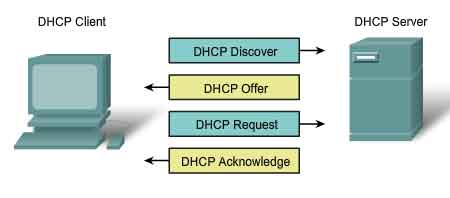
File Sharing Services and SMB Protocol
The Server Message Block (SMB) is a client/server file sharing protocol. IBM developed Server Message Block (SMB) in the late 1980s to describe the structure of shared network resources, such as directories, files, printers, and serial ports. It is a request-response protocol. Unlike the file sharing supported by FTP, clients establish a long term connection to servers. Once the connection is established, the user of the client can access the resources on the server as if the resource is local to the client host. SMB file-sharing and print services have become the mainstay of Microsoft networking. With the introduction of the Windows 2000 series of software, Microsoft changed the underlying structure for using SMB. In previous versions of Microsoft products, the SMB services used a non-TCP/IP protocol to implement name resolution. Beginning with Windows 2000, all subsequent Microsoft products use DNS naming. This allows TCP/IP protocols to directly support SMB resource sharing, as shown in the figure. The LINUX and UNIX operating systems also provide a method of sharing resources with Microsoft networks using a version of SMB called SAMBA. The Apple Macintosh operating systems also support resource sharing using the SMB protocol.
The Server Message Block (SMB) is a client/server file sharing protocol. IBM developed Server Message Block (SMB) in the late 1980s to describe the structure of shared network resources, such as directories, files, printers, and serial ports. It is a request-response protocol. Unlike the file sharing supported by FTP, clients establish a long term connection to servers. Once the connection is established, the user of the client can access the resources on the server as if the resource is local to the client host. SMB file-sharing and print services have become the mainstay of Microsoft networking. With the introduction of the Windows 2000 series of software, Microsoft changed the underlying structure for using SMB. In previous versions of Microsoft products, the SMB services used a non-TCP/IP protocol to implement name resolution. Beginning with Windows 2000, all subsequent Microsoft products use DNS naming. This allows TCP/IP protocols to directly support SMB resource sharing, as shown in the figure. The LINUX and UNIX operating systems also provide a method of sharing resources with Microsoft networks using a version of SMB called SAMBA. The Apple Macintosh operating systems also support resource sharing using the SMB protocol.
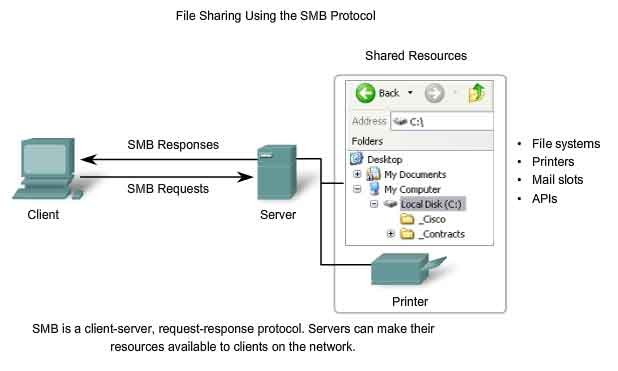
The
SMB protocol describes file system access and how clients can make
requests for files. It also describes the SMB protocol inter-process
communication. All SMB messages share a common format. This format uses a
fixed-sized header followed by a variable-sized parameter and data
component. SMB messages can:
-
Start, authenticate, and terminate sessions
- Control file and printer access
- Allow an application to send or receive messages to or from another device
P2P Services and Gnutella Protocol
You learned about FTP and SMB as ways of obtaining files, here is another Application protocol. Sharing files over the Internet has become extremely popular. With P2P applications based on the Gnutella protocol, people can make files on their hard disks available to others for downloading. Gnutella-compatible client software allows users to connect to Gnutella services over the Internet and to locate and access resources shared by other Gnutella peers. Many client applications are available for accessing the Gnutella network, including: BearShare, Gnucleus, LimeWire, Morpheus, WinMX and XoloX (see a screen capture of LimeWire in the figure). While the Gnutella Developer Forum maintains the basic protocol, application vendors often develop extensions to make the protocol work better on their applications. Many P2P applications do not use a central database to record all the files available on the peers. Instead, the devices on the network each tell the other what files are available when queried and use the Gnutella protocol and services to support locating resources. When a user is connected to a Gnutella service, the client applications will search for other Gnutella nodes to connect to. These nodes handle queries for resource locations and replies to those requests. They also govern control messages, which help the service discover other nodes. The actual file transfers usually rely on HTTP services. The Gnutella protocol defines five different packet types:
You learned about FTP and SMB as ways of obtaining files, here is another Application protocol. Sharing files over the Internet has become extremely popular. With P2P applications based on the Gnutella protocol, people can make files on their hard disks available to others for downloading. Gnutella-compatible client software allows users to connect to Gnutella services over the Internet and to locate and access resources shared by other Gnutella peers. Many client applications are available for accessing the Gnutella network, including: BearShare, Gnucleus, LimeWire, Morpheus, WinMX and XoloX (see a screen capture of LimeWire in the figure). While the Gnutella Developer Forum maintains the basic protocol, application vendors often develop extensions to make the protocol work better on their applications. Many P2P applications do not use a central database to record all the files available on the peers. Instead, the devices on the network each tell the other what files are available when queried and use the Gnutella protocol and services to support locating resources. When a user is connected to a Gnutella service, the client applications will search for other Gnutella nodes to connect to. These nodes handle queries for resource locations and replies to those requests. They also govern control messages, which help the service discover other nodes. The actual file transfers usually rely on HTTP services. The Gnutella protocol defines five different packet types:
-
ping - for device discovery
- pong - as a reply to a ping
- query - for file location
- query hit - as a reply to a query
- push - as a download request
Telnet Services and Protocol
Long before desktop computers with sophisticated graphical interfaces existed, people used text-based systems which were often just display terminals physically attached to a central computer. Once networks were available, people needed a way to remotely access the computer systems in the same manner that they did with the directly attached terminals. Telnet was developed to meet that need. Telnet dates back to the early 1970s and is among the oldest of the Application layer protocols and services in the TCP/IP suite. Telnet provides a standard method of emulating text-based terminal devices over the data network. Both the protocol itself and the client software that implements the protocol are commonly referred to as Telnet. Appropriately enough, a connection using Telnet is called a Virtual Terminal (VTY) session, or connection. Rather than using a physical device to connect to the server, Telnet uses software to create a virtual device that provides the same features of a terminal session with access to the server command line interface (CLI). To support Telnet client connections, the server runs a service called the Telnet daemon. A virtual terminal connection is established from an end device using a Telnet client application. Most operating systems include an Application layer Telnet client. On a Microsoft Windows PC, Telnet can be run from the command prompt. Other common terminal applications that run as Telnet clients are HyperTerminal, Minicom, and TeraTerm. Once a Telnet connection is established, users can perform any authorized function on the server, just as if they were using a command line session on the server itself. If authorized, they can start and stop processes, configure the device, and even shut down the system.
Long before desktop computers with sophisticated graphical interfaces existed, people used text-based systems which were often just display terminals physically attached to a central computer. Once networks were available, people needed a way to remotely access the computer systems in the same manner that they did with the directly attached terminals. Telnet was developed to meet that need. Telnet dates back to the early 1970s and is among the oldest of the Application layer protocols and services in the TCP/IP suite. Telnet provides a standard method of emulating text-based terminal devices over the data network. Both the protocol itself and the client software that implements the protocol are commonly referred to as Telnet. Appropriately enough, a connection using Telnet is called a Virtual Terminal (VTY) session, or connection. Rather than using a physical device to connect to the server, Telnet uses software to create a virtual device that provides the same features of a terminal session with access to the server command line interface (CLI). To support Telnet client connections, the server runs a service called the Telnet daemon. A virtual terminal connection is established from an end device using a Telnet client application. Most operating systems include an Application layer Telnet client. On a Microsoft Windows PC, Telnet can be run from the command prompt. Other common terminal applications that run as Telnet clients are HyperTerminal, Minicom, and TeraTerm. Once a Telnet connection is established, users can perform any authorized function on the server, just as if they were using a command line session on the server itself. If authorized, they can start and stop processes, configure the device, and even shut down the system.
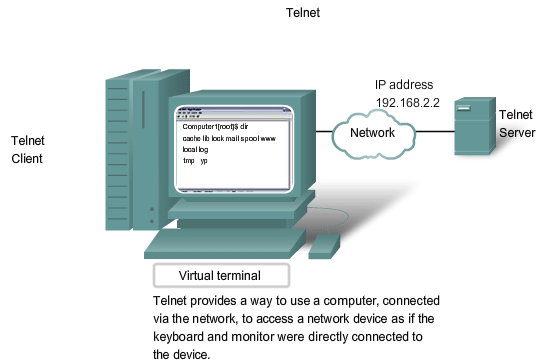
Telnet
is a client/server protocol and it specifies how a VTY session is
established and terminated. It also provides the syntax and order of the
commands used to initiate the Telnet session, as well as control
commands that can be issued during a session. Each Telnet command
consists of at least two bytes. The first byte is a special character
called the Interpret as Command (IAC) character. As its name implies, the IAC defines the next byte as a command rather than text.
Some sample Telnet protocol commands include:
Are You There (AYT) - Lets the user request that something appear on the terminal screen to indicate that the VTY session is active.
Erase Line (EL) - Deletes all text from the current line.
Interrupt Process (IP) - Suspends,
interrupts, aborts, or terminates the process to which the Virtual
Terminal is connected. For example, if a user started a program on the
Telnet server via the VTY, he or she could send an IP command to stop
the program. While the Telnet protocol supports user authentication, it
does not support the transport of encrypted data. All data exchanged
during a Telnet sessions is transported as plain text across the
network. This means that the data can be intercepted and easily
understood. If security is a concern, the Secure Shell (SSH) protocol
offers an alternate and secure method for server access. SSH provides
the structure for secure remote login and other secure network services.
It also provides stronger authentication than Telnet and supports the
transport of session data using encryption. Application layer iso osi. As a best practice, network professionals should always use SSH in place of Telnet, whenever possible.
Tidak ada komentar:
Posting Komentar